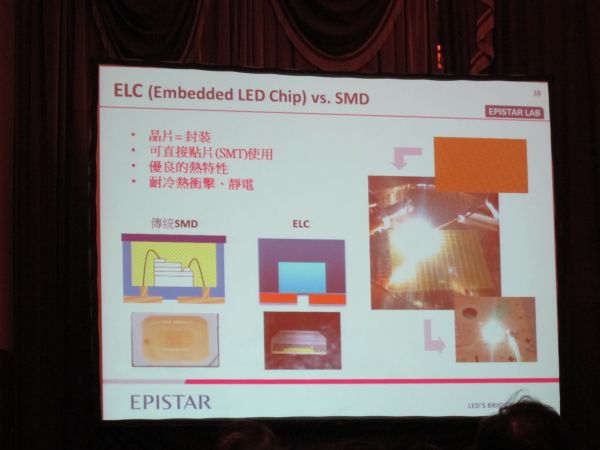Taiwanese LED chip manufacturer, Epistar, recently showcased its latest Embedded LED Chip (ELC) technology. The new ELC product reduces lead frame and wire bonding, and only requires a chip, phosphor and glue, said Hsieh Ming-Hsun, VP, R&D, Epistar at the LED Technology Forum held in Taipei, Taiwan. As a result, the chip can directly use surface-mount technology (SMT). The ELC can be applied in advance onto backlight products, and possess advantages of wide light beam angles, continued Hsieh. There is an opportunity to omit secondary optical lenses in the future.
The LED industry is continually seeking methods of lowering chip costs. Large LED chip manufacturers are actively developing package free products. Following TSMC Solid State Lighting and Toshiba’s release of package free LED chip products, Epistar has also unveiled its ELC product development progress at the forum. The new ELC product uses semiconductor manufacturing to reduce the package component, which includes the lead frame and wire bonding, said Hsieh. This process only leaves behind the chip, which can be used with phosphor powder plus glue and directly use SMT.
 |
|
Epistar's ELC power point presentation at LED Technology Forum in Taipei, Taiwan. (LEDinside) |
The LED lighting supply chain production phases are categorized from level zero to five. Epitaxy and chip manufacturing process belong to level zero, while level one involves LED chip packaging. In level two the LED is soldered onto a Printed Circuit Board (PCB), and LED modules are allocated to level three. Lighting sources are considered as level four products, and lighting systems as level five. According to sources, Epistar’s new ELC product aims to reduce the level one package process.
The purpose of R&D is to find all kinds of technological development possibilities, said Hsieh. Epistar began to invest in the R&D of ELC technology back in 2009. Besides reducing packaging process, the ELC also possesses advantages of good thermal resistance (from -45 degrees Celsius to 120 degrees Celsius), and is static electricity resilient. However, the technology’s disadvantage is it has a different manufacturing process that requires solving material issues during manufacturing.
Epistar’s ELC product can be applied in backlight and lighting market in the future. Hsieh also revealed ELC will first be introduced into LED-backlit TV applications, which can further lower chip volume usage. He also mentioned without packaging, ELC has an advantage of wider beam angles that can reduce the need for secondary optic lenses in TV, and further cut backlit-LED TV costs.
By using Epistar’s ELC chip in 32-inch direct-view type LED TV, chip usage was reduced to below 20 pcs. First generation ELC products applied in backlight products still used secondary optic lenses.












